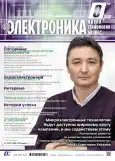Measuring the field strength of radio interference from automotive equipment taking into account the parameters of the radio channel used
- Authors: Drobzhev D.1, Ivanov G.1, Litvinova N.1, Osaulko V.1, Rozvadovsky A.1
-
Affiliations:
- Испытательный Центр «Омега», Севастопольский филиал ФГБУ НИИР
- Issue: No 9 (2023)
- Pages: 128-137
- Section: Test and measurement
- URL: https://journals.eco-vector.com/1992-4178/article/view/633101
- DOI: https://doi.org/10.22184/1992-4178.2023.230.9.128.137
- ID: 633101
Cite item
Abstract
The article presents a modified technique for measuring the field strength of broadband and narrowband interference from automotive equipment using GSM and UMTS technologies for data transmission, as well as making a voice call. The results of testing the methodology are presented using the example of measuring the level of radio interference of automobile devices for calling in-vehicle emergency services.
Full Text
About the authors
D. Drobzhev
Испытательный Центр «Омега», Севастопольский филиал ФГБУ НИИР
Author for correspondence.
Email: drobzhev@niir.ru
ведущий инженер
Russian FederationG. Ivanov
Испытательный Центр «Омега», Севастопольский филиал ФГБУ НИИР
Email: ivanovga@niir.ru
инженер 1 категории
Russian FederationN. Litvinova
Испытательный Центр «Омега», Севастопольский филиал ФГБУ НИИР
Email: litvinova@niir.ru
специалист
Russian FederationV. Osaulko
Испытательный Центр «Омега», Севастопольский филиал ФГБУ НИИР
Email: osaulko@niir.ru
заместитель начальника отдела испытаний
Russian FederationA. Rozvadovsky
Испытательный Центр «Омега», Севастопольский филиал ФГБУ НИИР
Email: raf@niir.ru
заместитель начальника отдела радиотелекоммуникационного оборудования
Russian FederationReferences
- Manso M. et al. The Application of Telematics and Smart Devices in Emergencies. In: Gravina R., Palau C., Manso M., Liotta A., Fortino G. (eds) Integration, Interconnection, and Interoperability of IoT Systems. Internet of Things (Technology, Communications and Computing) // Springer, Cham. 2018.
- Mumtaz S., Huq K. M. S., Ashraf M. I., Rodriguez J., Monteiro V., Politis C. Cognitive vehicular communication for 5G // IEEE Communications Magazine, vol. 53, no. 7, pp. 109–117, 2015.
- Bonyár A. et al. A review on current eCall systems for autonomous car accident detection // 2017 40th International Spring Seminar on Electronics Technology (ISSE), Sofia, Bulgaria, 2017, pp. 1–8.
- Cabo M., Fernandes F., Pereira T., Fonseca B., Paredes H. Universal Access to eCall System // Procedia Computer Science, Volume 27, 2014, pp. 104–112.
- Carutasu G. Further challenges of eCall service and infrastructure // MIT 2016: proceedings of the 14th International Conference on Management and Innovative Technologies, Fiesa, Slovenia, 5th-7th September 2016, pp. 68–72.
- Kaminski T. et al. Effect Analysis on the Implementation of Automatic Emergency Call System eCall. In: Kaminski T., Ucinska M., Kaminska E., Filipek P. Journal of KONES Powertrain and Transport, 2011, vol. 18, no. 4.
- Beeharee A., Fremont G., Grau G., Campo R., Lovas T., Besnard L. Enabling Next Generation Emergency Call Service // Procedia – Social and Behavioral Sciences, Volume 48, 2012, pp. 2718–2727.
- Uhlir D. et al. Practial overview of commercial connected cars systems in Europe. In: Uhlir D., Sedlacek P., Hosek J. (eds) 2017 9th International Congress on Ultra Modern Telecommunications and Control Systems and Workshops (ICUMT), Munich, Germany, 6–8 Nov. 2017.
- Sun L, Li Y., Gao J. Architecture and Application Research of Cooperative Intelligent Transport Systems // Procedia Engineering, vol. 137, pp. 747–753, 2016.
- Festag A. Cooperative intelligent transport systems standards in Europe // IEEE communications magazine, vol. 52, no. 12, pp. 166–172, 2014.
- Rybak T., Steffka M. Automotive electromagnetic compatibility (EMC). ISBN: 1-4020-7713-0. 2004.
- Zhai L. Electromagnetic Compatibility of Electric Vehicle. ISBN 978-981-33-6164-5, 2021.
- Weston D. A. Electromagnetic Compatibility: Methods, Analysis, Circuits, and Measurement. ISBN 978-1482299502. 2016.
- Michalski W. Recommendations and Regulations of the European Commission Regarding the Pan-European eCall Paper // Journal of Telecommunivations and Information Technology, 2009, vol.4, pp.138–145.
- Wisman T. eCall and the Quest for Effective Protection of the Right to Privacy // SSRN. September 17, 2015.
- Regulation (EU) 2015/758 of the European Parliament and of the Council of 29 April 2015 concerning type-approval requirements for the deployment of the eCall in-vehicle system based on the 112 service and amending Directive 2007/46/EC
- EN 16072:2011 Intelligent transport system – eSafety – Pan-European eCall operating requirements.
- EN 16062:2011 Intelligent transport systems – eSafety – eCall high level application requirements (HLAP).
- CEN/TS 16454:2013 Intelligent transport systems – ESafety – ECall end to end conformance testing.
- EN 15722:2011 Intelligent transport systems – eSafety – eCall minimum set of data (MSD).
- EN 16102:2011 Intelligent transport systems – eCall – Operating requirements for third party support.
- UN Regulation No. 10 Uniform measures related to the unification of vehicles in terms of their electromagnetic compatibility, Revision 6 – Amendment 1, Date of entry into force: 25 September 2020.
- CISPR 12 Vehicles’, motorboats’ and spark-ignited engine-driven devices’ radio disturbance characteristics – Limits and methods of measurement. Fifth edition 2001 and Amd1: 2005.
- CISPR 25 Limits and methods of measurement of radio disturbance characteristics for the protection of receivers used on board vehicles. Second edition 2002 and corrigendum 2004.
- ETSI TS 151 010-1 Digital cellular telecommunications system (Phase 2+) (GSM).
- ETSI TS 134 121-1 Universal Mobile Telecommunications System (UMTS).
- ITU-R SM.1539-1 Variation of the boundary between the out-of-band and spurious domains required for the application of Recommendations ITU-R SM.1541 and ITU-R SM.329.
Supplementary files













